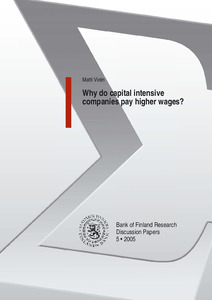Why do capital intensive companies pay higher wages?
Virén, Matti (05.02.2005)
Numero
5/2005Julkaisija
Bank of Finland
2005
Julkaisun pysyvä osoite on
https://urn.fi/URN:NBN:fi:bof-201501291028Tiivistelmä
An obvious answer to this question is the capital-skill
complementarity hypothesis originally proposed by Zwi Griliches
(1969). But the relatively poor performance of this hypothesis
suggests that other explanations are needed. Here we consider the
labour union behaviour in the wage bargaining process as such an
alternative. The explanation is based on the observation that
capital intensive companies are more vulnerable to strike threats
and may thus more easily give in for union wage demand. Thus, the
bargaining power of unions is related to the capital-labour ratio.
This paper provides some tests for these hypotheses with panel data
for Finnish companies. The results give support to the wage
bargaining hypothesis.
Key words: wages, bargaining, wage distribution, panel data
JEL classification numbers: J31, J51
complementarity hypothesis originally proposed by Zwi Griliches
(1969). But the relatively poor performance of this hypothesis
suggests that other explanations are needed. Here we consider the
labour union behaviour in the wage bargaining process as such an
alternative. The explanation is based on the observation that
capital intensive companies are more vulnerable to strike threats
and may thus more easily give in for union wage demand. Thus, the
bargaining power of unions is related to the capital-labour ratio.
This paper provides some tests for these hypotheses with panel data
for Finnish companies. The results give support to the wage
bargaining hypothesis.
Key words: wages, bargaining, wage distribution, panel data
JEL classification numbers: J31, J51
